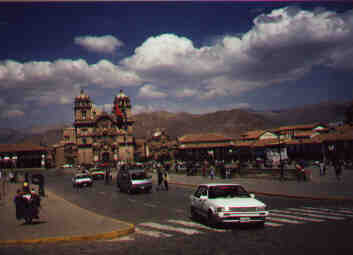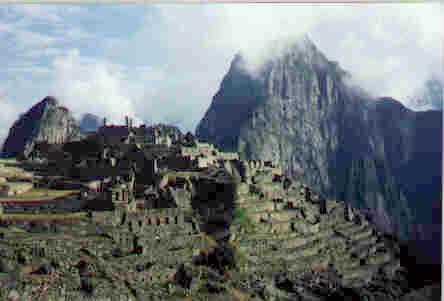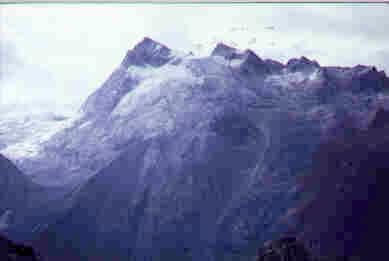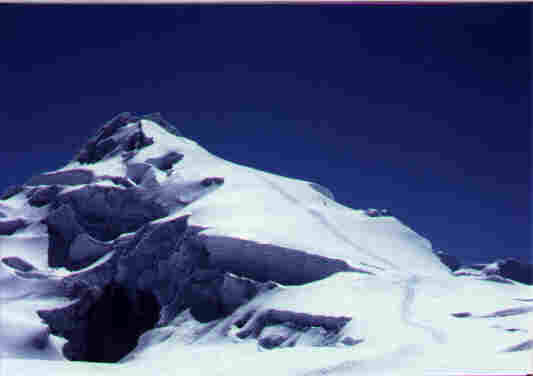Peru 98
Click here for #Contacts
John & Kris Wallack
The flight to Peru is almost as long as a flight to Europe,
but no jet lag! Flying from Colorado to Lima in July is only one time zone,
so we slept on the jet Saturday night and were at the Lima Airport at 4
AM Sunday morning. While waiting for our connecting flight to Cuzco, we
exchanged $US dollars for New Soles (2.90/USD) and sampled some Peruvian
coffee. Our group of six was: John and Kris Wallack, Norm Henderson,
Margaret Jezek, Deac Lancaster and Stu Knapp. We have hiked and climbed
together in the states for a number of years. We were all excited
to be together for everyone’s first trip to South America. We were
lucky that we all got window seats on the left side of the plane for the
best views of the Andes when approaching the ancient Inca capital situated
at 11,000 feet elevation.

The Cuzco valley looked surprisingly arid from the plane. Somehow,
I expected more vegetation and greenery. The day was cool and clear like
an autumn day in Colorado. We struggled with our mountain of duffels at
the airport parking lot. The wheels on the cart seemed ready to flop over
under the strain. As we arrived, we were immediately greeted by Bobby from
International Cusco Adventures. Bobby was our point of contact while we
were there, while the e-mail arrangements were generally handled by Maria.
Cuzco was our base for the first week in Peru. We enjoyed an interesting
walking tour around town Sunday afternoon. Hotel Carlos V proved to be
well situated and had hot water -- most of the time! We were 5 minutes
from Plaza de Armes, convenient for shopping and sightseeing. We walked
up to the impressive ruins of Sacsayhuaman, with rocks weighing up to 300
tons shaped so accurately that you could not fit a charge card between
them! We ended our first day in a Peruvian restaurant on the Plaza
(Paititi) listening to Andean flutes and checking out the local Cuzcañia
brew. It was a fine end to a long day of travel and amazing range of new
sights and experiences.
Our strategy was to gain some acclimatization and conditioning for the
second week’s climbing by trekking the 45 km Inca Trail to Machu Picchu.
The trek starts 82 km north-west of Cuzco along Rio Urubamba. Our "collectivo",
or minivan, was waiting for us at 6AM sharp Monday morning. Maria Dolores
of INTERNATIONAL CUSCO ADVENTURES was our local agent. She did a
great job of coordinating all the logistics for the Cuzco segment of our
trip. We piled into the van and were joined by our English speaking guide,
Wilbur. We were soon rolling along the country roads of Peru with Andean
flute tunes on the cassette player.
The trek began at a dusty pullover on the road at
"kilometer 82". We me the cook and porters and started hiking through
the arid Rio Urubamba valley, similar in many ways to the Grand Canyon.
Here, the century plants were gigantic, with thick leaves arching 5 feet
off the ground. We were soon aware that Wilbur’s specialty was botany,
as he offered the Latin names of most of the plants he pointed out along
the way. By the stats, the first day was not supposed to be a tough day,
but several of us agreed that it was the most tiring. More likely, it was
the accumulation of several nights short on sleep and long on packing,
shuffling and sorting. Deac mentioned several times to beware of stocky
guides with muscular legs! As dusk settled in at the Huayllabamba campsite,
we saw two condors soaring around a nearby peak.
We all slept about 10 hours and felt well rested. The first breakfast
set the tone - hot pancakes with sliced bananas and chocolate sauce. Rough
life, this trekking. We all really enjoyed the luxury of cook and porters.
The routine was very similar to trekking in Nepal. Morning tea in the tent
at about 6AM, followed by a cooked breakfast. At mid-day, we enjoyed a
leisurely trekkers lunch. Afternoon tea and evening meals were served in
the group dining tent at the campsite.
Day two was considered the big push because of the crossing of WarmiWañusqa
(Dead Woman’s) Pass at 13,747 ft. Wilbur pointed out the reason for
the name: the skyline at the pass formed the silhouette of a woman’s
face and breasts. The trail went steadily up, and soon we were enjoying
a cloud forest rather than the arid steppe grass. There was a Condor again,
circling the pass! The relief between peaks and the Urubamba Gorge was
quite impressive. Our camp was about 1.5 miles down from the pass
at a very crowded river campsite called Pacamayo. Tents were pitched
on every level space available. We arrived about 1:30 PM and none
of us felt as tired as the day before even though we had climbed the pass.
The next morning we started out climbing steeply up to the ruins of
Runkuracay. This oval shaped ruin had an excellent view of the river
valley. We continued uphill, climbing many steps to the second pass
at 13,123ft. The steps were a novelty at first, then, Kris decided
it was a form of Inca torture! It was hard to keep any kind of climbing
rhythm on the uneven steps. Finally, we reached the pass and started down
through a high mountain jungle to more ruins at Sayacmarca. This
Inca site had reconstructed baths and aqueducts. A beautiful ridge
walk brought us to the third pass on the Inca Trail. After we crossed
the pass, Wilbur took us on the Hiram Bingham trail. This trail is
above the more popular pathway and it was nice to walk without the crowds
of hikers for a little way. We stopped for lunch at a point that
looked directly down on Machu Picchu. Quite a treat! Our camp
was just below the terraces of Huinay Huayna. A nice campsite
was spoiled by a group that talked and sang until well past midnight.

We were up at 4:30 AM to try to get to Inti Punku, the Sun Gate, for
sunrise. Unfortunately, we couldn’t see Machu Picchu through the
fog! By the time we hiked the rest of the way to Machu Picchu and
bought our entry tickets, the fog had lifted. Wilbur explained what
the different areas of Machu Picchu were used for and gave us a lot of
historical background. It added tremendously to the visit to have
a knowledgeable guide. Machu Picchu was truly a special place and
we all were impressed with the beauty of the place. We had to move
on though, as we had a train to catch at 3:00 PM in Aguas Calientes, the
little town below Machu Picchu. The train trip back to Cuzco travels
through a beautiful river gorge. The Andes tower above the gorge
and a wild river winds through the valley floor. We arrived back in Cuzco
about 7:30 PM after a series of switchbacks brought the train down from
the ridge overlooking the city. It had been a long day but one we
will remember for a long time.
Friday was our day to make the move from Cuzco to Huaraz for the second
leg of our trip. Our flight from Cuzco to Lima was late, but our minibus
was waiting for us at the Lima Airport. Our driver, Fernando, was
like a private tour guide, giving us great info throughout the entire 8
hour drive. Lima was completely gray. It is located on the coastal desert
of Peru and is shrouded by with mist and fog called garúa. The cold
Humbolt currents of the Pacific condense the moisture in the air, leaving
the coastline quite arid. The coastline north of Lima was a moonscape of
sand dunes with only chicken farms and a salt processing plant. We stopped
for a lunch of fried fish at the coastal town of Barranca, before heading
inland up the Rio Fortalaza valley.
The Rio Fortalaza valley floor was lush and green, but the mountainous
sides to the valley were completely devoid of vegetation. Starting at sea
level, the road winds its way up to Conocacha Pass at 4080m, crossing over
the Cordillera Negra range into the Rio Santa valley. It was just sunset
at the pass, as we got our first views of the snow clad Cordillera Blanca
range with a tint of alpenglow. We were pleased to pull up to Hotel Andino
in Huaraz at 7:30PM. After several months of exchanging cordial e-mails,
we finally met Jenny. She was as friendly in person as in correspondence.
French-swiss born, Jenny runs her hotel with a distinctly European efficiency
and style. As she saw Deac with a water bottle in his hand, she quickly
asked "coca tea?" and wisked the vessel into the hands of a passing waiter
with the request. Jenny had a twinkle in her eye, as she cajoled Kris about
looking too stressed for "holiday" and told her to relax and kick back.
We were soon checked in, showered and enjoying some Andean flute music
in Jenny’s fine restaurant at the hotel. Jenny did a super job making our
arrangements in Huaraz for transportation as well as donkeys, cook and
other support.
The next morning there was a feeling of excitement as we loaded Fernando’s
bus in front of the hotel. The morning air was cool, but the sky was clear
and the views looking north at the snow-covered Cordillera Blanca were
inviting. Gary, Cindy and Bill came down to the front gate to wish us well,
while the cook and Fernando were loading the food boxes. It was amazing
how much stuff we were taking for our mountain outing. We certainly had
not made much of an effort to minimize, but rather decided to enjoy the
relative luxury of a cook and cook tent. Jenny had made all the food arrangements
with Augustine, the cook.
We had all enjoyed our last showers for several days and had a tasty
buffet style breakfast, so when the bus was loaded, we climbed aboard and
started off for the Pisco trailhead to meet the donkey driver, or arriero.
We were heading north up the center of the Rio Santa valley. We had great
views of Huascaran on our right. We were looking forward to see the Llanganuco
valley and Pisco trailhead, but it was not to be. As we turned off the
main road in the town of Yungay to drive to the trailhead, we were talking
about the 1970 alluvion that buried the town with 18,000 inhabitants. People
motioned for us to turn around. There had been a land slide and it was
blocking the road. Sure enough – the boulders were still rolling! We stopped
the bus to see for ourselves. We didn’t know if it would take a day
or a week to clear the road, nor whether it would continue to slide, so
back to Yungay we went. We decided on an alternate plan of the Ishinca
valley. It was on of the peaks on the original list considered for this
trip and we had passed the access to the valley earlier. In a couple of
hours and with the help of our driver and the cook, we were loading a new
set of donkeys in the village of Huillac. The trek into the basecamp area
was about 7 miles up to 14,300 ft. The last mile or so went slowly as the
light faded. Margaret was feeling a bit of the altitude. Having a cook
and group cook tent worked out well. It was 6:30PM and dusk when
we arrived at camp. We used headlamps for the last 20 minutes of the hike.
Augustine had already set up the cook tent and started preparing the meal.
We enjoyed hot soup and spaghetti. Were settled in for our six day stay.
Actually, a day in, four days at camp, and a day out.

URIS (17,800ft)
Our first day was a day of acclimatization, so after our pancake breakfast
and lounging in camp, we hiked up the start of the route for Uris (5420m/17782’).
From our high point, we got a better view of Ishinca (5530m/18143’) as
well as the end of our valley. After lunch, we hiked up part of the way
to Ishinca. The place was spectacular. There were rock spires and outcrops
up the sides of the canyon and glacier clad peaks at the head of the valley.
We got a better view of Uris from the south side of the valley. Uris, we
learned, is Quechuan for brain. We guessed that the cortex-looking end
of the glacier prompted the name. Margaret, Norm Kris and I hiked up to
a meadow at about 15,200 ft, but Deac and Stu felt full of energy and continued
on up to 16,100 and reconoitered the high camp. Both came back excited
about the the Ishinca climb and suggested at dinner that we go for high
camp the next morning. I was tempted, but felt that climbing Uris first
allowed us to sleep lower two more nights, giving us the best acclimatization
we could manage on our short schedule. Norm supported the notion of Uris
first, and we all agreed to stay with the plan. I felt like I had thrown
a wet blanket over the excitement of moving to high camp.
We were up early the next morning to climb Uris. The route follows a
lateral moraine up from the valley floor. Soon, we were able to see much
better views of the near peaks. At about 16000 ft., the moraine
trail gives way to scrambling through granite blocks and boulders. At 16700
ft., we started up a short section of glacier. There was no new snow.
The conditions were icy, with a fairly rough and rotten surface. It was
about 40 degrees at the start, but flattened out higher up. In about an
hour, we were removing the crampons for the final 30-minute scramble to
the summit. The sky had clouded up, but it did not rain. The summit was
rather narrow, but we enjoyed great views of the Cordillera Blanca. On
the way down at about 17000, we saw a Condor soaring about 300 ft. from
us. That evening while we were eating, it rained. We felt we had "snatched
one from the hands of defeat."
The next day we waited until the sun hit the tent to get out of our
sleeping bags. Our cook, Augustine, soon had the breakfast going.
Sitting in the morning sun at this camp was truly a relaxing bit of vacation.
We took our time loading the packs to move up to high camp at 16,000. Augustine
and Deac were staying at base camp, although Deac helped carry the gear
up. Our camp was on the sandy shore of a small glacial lake. . The silt
was so thick that the PUR filter elements clogged after 1.5 liters. Stu
constructed camp furniture out of boulders. There were two wind screens
for the stove and we each had a rock chair to sit on. At dusk, we noticed
the cooler air as we savored a freeze dried dinner around the stoves.
The route to Ishinca followed to the right of the lake and up a gully
at the edge of the glacier. We went too far to the right and wandered for
an hour amongst moraine and rock blocks as big as cars lodged into the
ice. We finally broke out onto the glacier. We put on the crampons and
enjoyed a steady, pleasant plod to the top. The views on the glacier were
classic. Here we were finally walking up on a glacier covered peak in Peru!
Just short of the summit, there was a corniced overhang to the actual peak.
I belayed Stu up, and he inspected the final bit. Stu declined to go up
the last bit, as the overhang was fairly well perforated with ice ax holes
and did not look particularly stable. I followed suite. The return trip
on the glacier was perhaps more pleasant than the ascent, as you breath
easier and view the neighboring peaks without lifting your head. We soon
re-joined Deac at the high camp and packed the heavy loads again. WE had
a rather fine trek back down to basecamp, enjoying a fine sunset with Alpenglow
on the way down. Augustine seemed pleased to see us return. Another fine
dinner in the cooktent. Our arriero and his son appeared outside the tent
while we ate, so we knew that everything was set for our walk out in the
morning.

ISHINCA (18,200ft)
The final morning in basecamp was another day to sleep in. The hike
out was a pleasant downhill stroll in the sunshine. WE were all feeling
rather mellow. The rendezvous with Fernando and his bus all went like clock
work. The hot shower at Hotel Andino was rather fine. I walked out onto
the lawn to find Stu writing some post cards. He shared half his cold beer.
What a life! Deac, Stu, Norm and I then walked down to city center
to go to the Post Office and buy some beer. I finally get to pay my wager
from the Super Bowl bet -- 2 six-packs of Peruvian Beer. We all met on
the terrace outside our room for a happy hour celebration of the return
to showers and a good mountain trip. We all enjoyed another fine meal at
the restaurant.
For our return to Lima, we used Cruz del Sur, which was comfortable
and on time. The whole trip went smooth. We definitely shall return!
Contacts
SAEC_Lima
montague@amauta.rcp.net.pe
Maria Dalores
INTERNATIONAL CUSCO ADVENTURES
inqusa@qenqo.rcp.net.pe
Jenney
Andino Hotel
andino@mail.cosapidata.com.pe
Back to Wallack's Homepage



